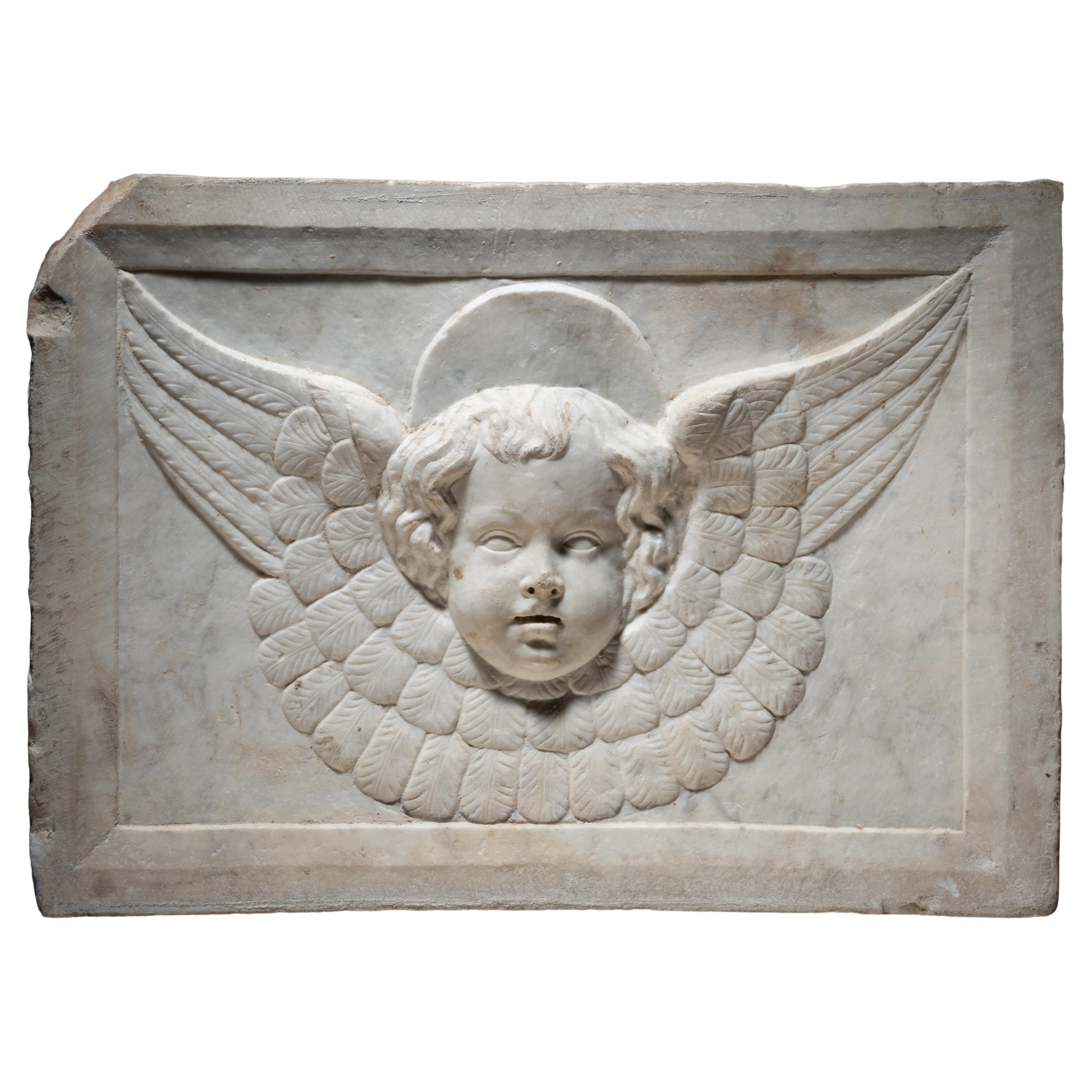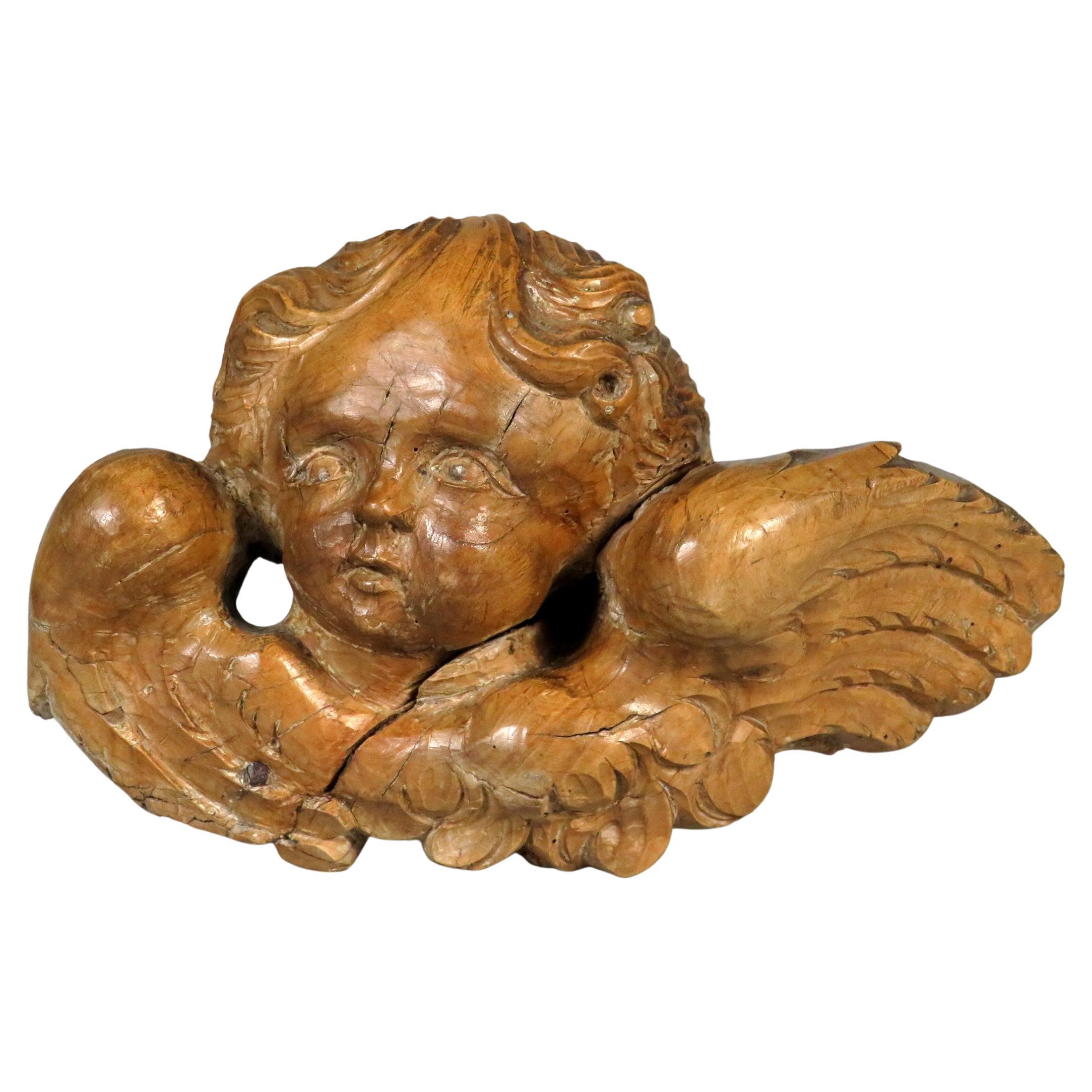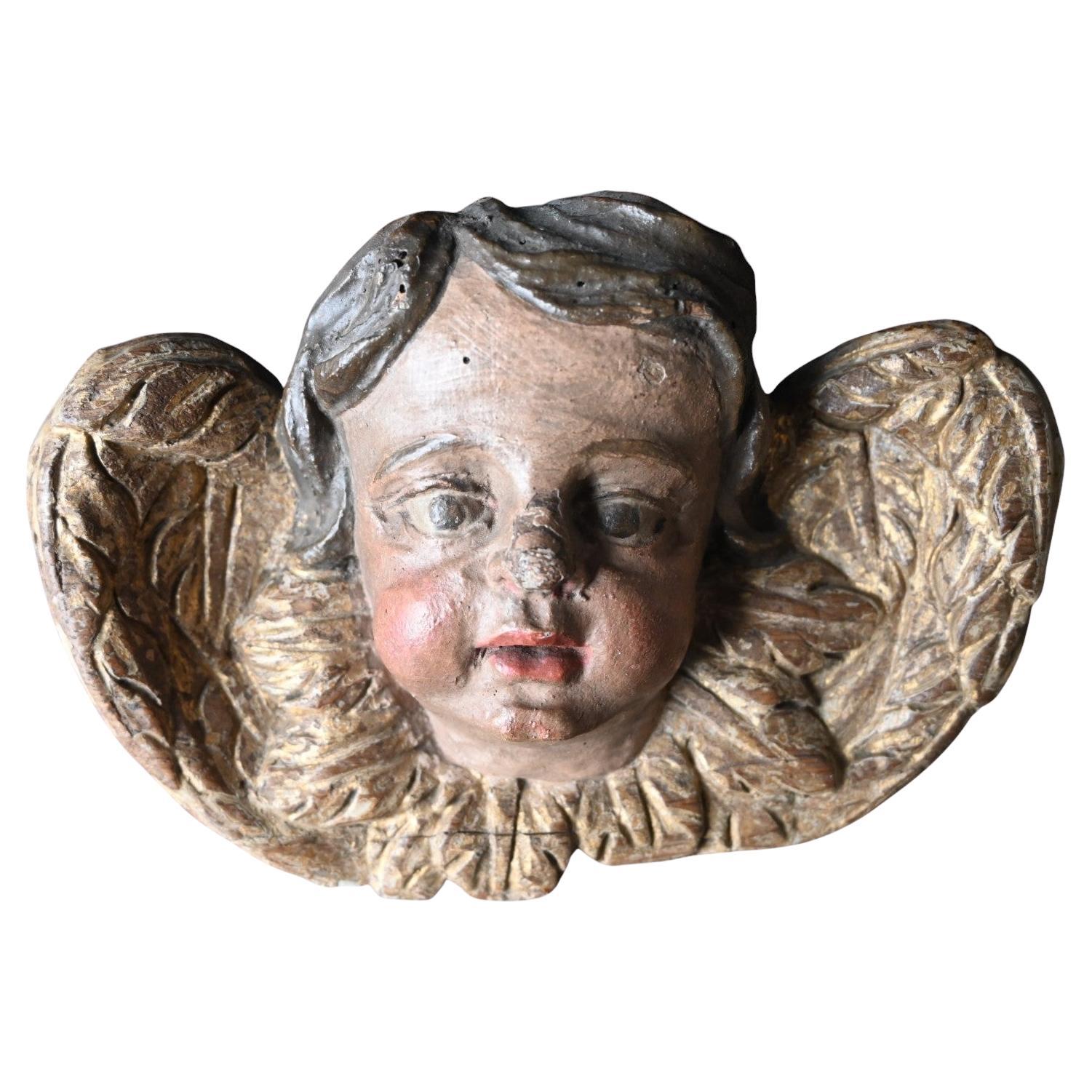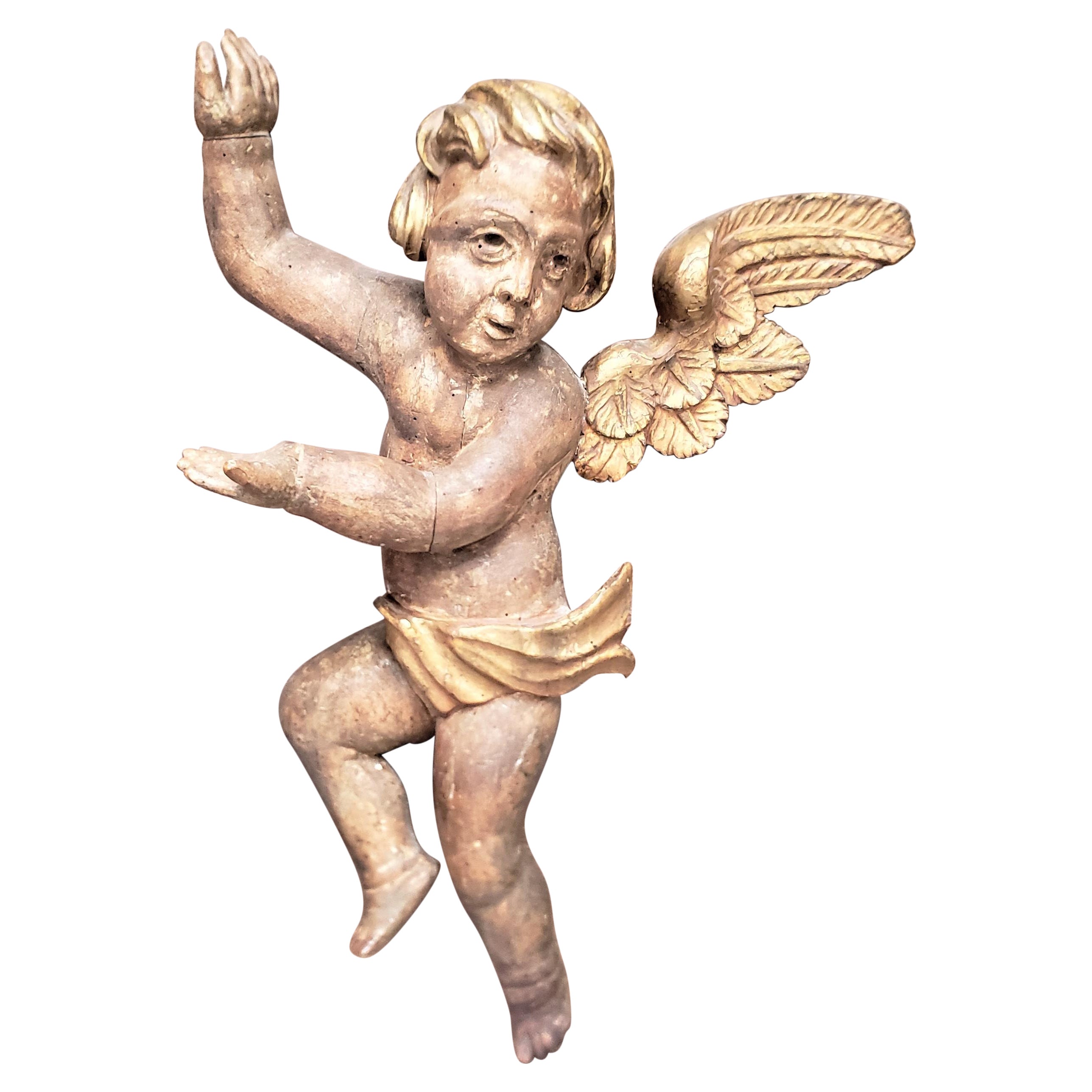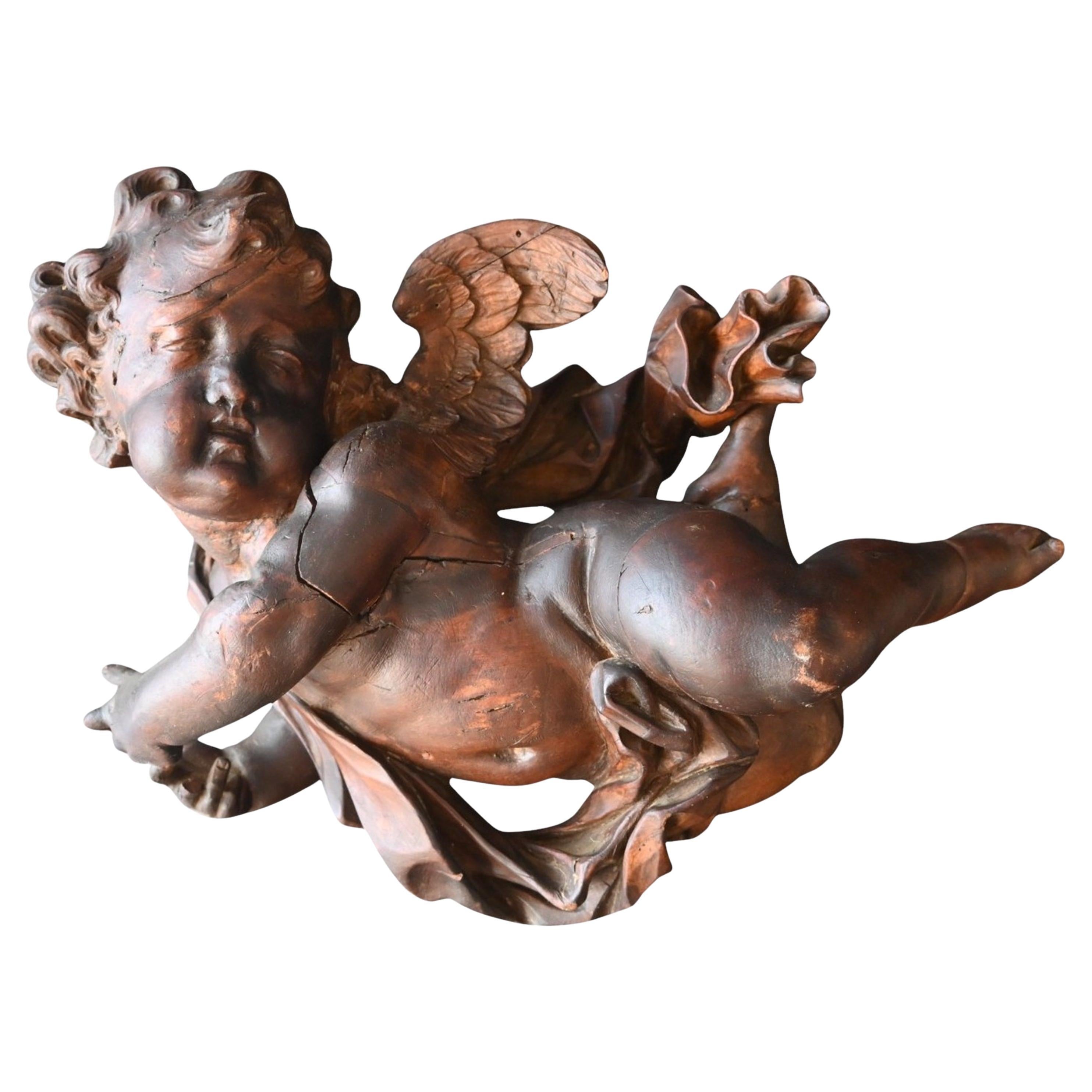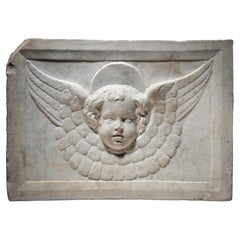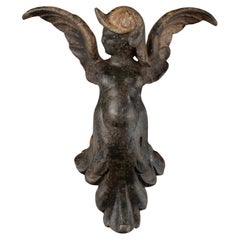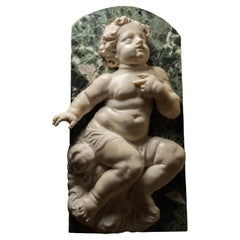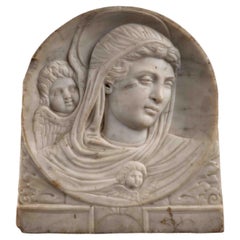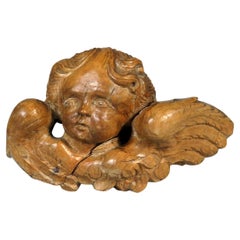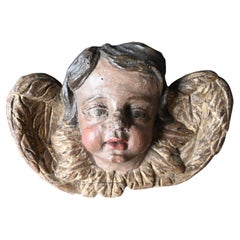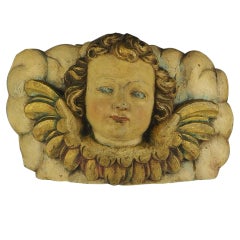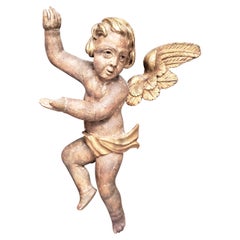Items Similar to Renaissance Winged Cherub Relief
- Florence, 15th century
Want more images or videos?
Request additional images or videos from the seller
1 of 6
Renaissance Winged Cherub Relief
- Florence, 15th century
$17,813.79
£13,187.32
€15,000
CA$24,543.11
A$27,344.49
CHF 14,275.12
MX$331,998.59
NOK 179,428.94
SEK 169,603.93
DKK 114,212.66
About the Item
Renaissance Winged Cherub Relief
Florence, Second Half of the 15th Century
Stone with traces of polychromy
Provenance: Important private collection, Northern Italy
This exceptional Renaissance relief represents the head of a winged cherub in profile. With wide, outlined eyes and a slightly parted mouth, the cherub’s expression exudes an almost ecstatic emotion, capturing the divine joy of a celestial being in the presence of God.
The decorative exuberance of the work is reflected in the intricate detailing of the cherub's features. The four wings, elegantly spread in perspective, frame the cherub’s face, drawing attention to the full cheeks and the delicate modeling of the facial features. The dynamic interplay of depth and movement, achieved through masterful relief carving, lends the composition an ethereal lightness and grace.
Although the exact architectural context and purpose of the relief may never be fully determined, the profile view suggests that it was likely part of a frieze, possibly surrounding a central composition.
The artist’s technical prowess is evident throughout, demonstrating a deep understanding of the refined elegance characteristic of Tuscan workshops. The pronounced relief of the wings in the foreground, nearly detached from the background, is a hallmark of Florentine Renaissance sculpture. This contrasts with the more subtly modeled wings in the background, emphasizing the cherub’s serene face. The artist’s skillful treatment of details, such as the masterfully rendered ear, the plump cheeks, and the fluid arrangement of the wings encircling the face, showcases the refinement of early Renaissance Florentine style.
The sculptural technique, particularly in the carving of the eyes, the soft arch of the eyebrows, and the precise modeling of the ear, suggests the hand of an artist with exceptional technical ability. These features reflect the polished style of Renaissance sculptors working in Florence in the 15th century, including masters like Desiderio da Settignano and Antonio Rossellino. The rounded face with delicate features, the finely carved hair, and the wings are reminiscent of the later circular reliefs found in the Cappella dei Pazzi, which Cardellini (1962) attributed to Settignano. The cherub's rounded cheeks, finely etched hair, and soft facial features echo the refined aesthetic seen in Settignano’s works.
The resemblance to other Florentine masters is striking. The facial type—wide-set eyes, a high forehead, and a rounded yet slightly oval face—bears a strong similarity to the figures in Rosselli’s works, notably the reliefs of the Annunciated Angel and the Virgin (c. 1460-61) at San Petronio Basilica in Bologna, where similar facial features and proportions are evident. These same expressive faces also appear in the decoration of the Sala degli Angeli in the Palazzo Ducale, Urbino, and in a stone relief by Rossellino now housed in the Budapest Museum of Fine Arts.
Another notable comparison can be drawn with the winged cherubs in Andrea Della Robbia’s Madonna and Child with Saints Stephen and Lawrence (1489) in Prato, further solidifying the ties to the Florentine tradition.
Rooted firmly in the illustrious Florentine Renaissance, this relief exemplifies the aesthetic ideals of the early Renaissance. The artist’s meticulous attention to the cherub's features and the refinement of the composition suggest an intimate familiarity with the sculptural traditions and artistic ideals of Florence during this period.
This elegantly crafted relief stands as a quintessential example of Renaissance Italian art, offering insight into the spiritual and artistic sensibilities of 15th-century Florence.
- Dimensions:Height: 6.11 in (15.5 cm)Width: 13 in (33 cm)Depth: 5.12 in (13 cm)
- Style:Renaissance (Of the Period)
- Materials and Techniques:
- Place of Origin:
- Period:
- Date of Manufacture:15th century
- Condition:Wear consistent with age and use.
- Seller Location:Bruxelles, BE
- Reference Number:1stDibs: LU6666244060222
About the Seller
5.0
Vetted Professional Seller
Every seller passes strict standards for authenticity and reliability
1stDibs seller since 2022
15 sales on 1stDibs
Typical response time: 1 hour
- ShippingRetrieving quote...Shipping from: Bruxelles, Belgium
- Return Policy
Authenticity Guarantee
In the unlikely event there’s an issue with an item’s authenticity, contact us within 1 year for a full refund. DetailsMoney-Back Guarantee
If your item is not as described, is damaged in transit, or does not arrive, contact us within 7 days for a full refund. Details24-Hour Cancellation
You have a 24-hour grace period in which to reconsider your purchase, with no questions asked.Vetted Professional Sellers
Our world-class sellers must adhere to strict standards for service and quality, maintaining the integrity of our listings.Price-Match Guarantee
If you find that a seller listed the same item for a lower price elsewhere, we’ll match it.Trusted Global Delivery
Our best-in-class carrier network provides specialized shipping options worldwide, including custom delivery.More From This Seller
View AllCercle of Jacopo della Pila - Marble relief depicting a winged Cherub
Located in Bruxelles, BE
Cercle of Jacopo della Pila (Lombard, in Naples 1471-1502)
Marble relief depicting a winged Cherub
Naples, second half of15th century
40 x 57 x 12 cm
Exquisitely carved, this relief portrays a winged cherub with cascading hair and delicate features. The cherub's plump, smooth countenance, rounded cheeks, outlined lips, and finely drawn nose emanate a sense of tenderness. The quadrangular module, is adorned with a carved frame. The relief ascends gradually, transitioning from the low relief of the wings to the high relief of the head.
The rectangular frame and the subtly curved form of the artwork suggest that the relief likely adorned the upper part of an arch or a vaulted chapel. The type is that of the perspective room with a coffered ceiling decorated with figures of winged cherubs, which is found in various Neapolitan chapels of the 15th century. Coffered ceilings attest to the recovery of antiquity and the search for luxury in Renaissance architecture, first in Florence, then in Rome and Naples. The majority of the numerous family chapels and tombs built during the late fifteenth century in south of Italy employ the new formal vocabulary of the Florentine Renaissance in a self-confident manner that permitted a broad spectrum of variations.
The escalating admiration for the classical world, coupled with the development of perspective, significantly contributed to the Renaissance endorsement of coffered ceilings. This artistic and constructive device drew inspiration from the intricate marble patterns observed in historical landmarks such as the Arch of Titus, the Temple of Vesta in Tivoli, the Pantheon, and the Basilica of Maxentius. A distilled product of both mathematical and artistic cultures, deeply scrutinizing the ancient world, the coffered ceiling plays a vital role in the perspective construction of space with its regular and directional geometry. The motif of the coffered ceiling decorated with cherubs in relief was introduced in Naples by Francesco Laurana in the plastic decoration of the Arch of Castelnuovo. Laurana's impact on the art scene in the south of Italy was profound. The introduction of the winged cherub into the region's artistic vocabulary bridged the gap between the classical and the contemporary, creating a synthesis that resonated with both aesthetic and spiritual sensibilities. His influence extended beyond the immediate visual appeal, shaping the cultural identity of the Renaissance in southern Italy. Although the plastic decoration of the Arch of Castelnuovo cannot certainly be ascribed to a mature Renaissance style, it was precisely on this occasion that the sculptors who worked there could get to know and export throughout the Italian peninsula that type of "Florentine classicism" which, even in the 15th century Naples, was conditioned by the Burgundian culture imported into the Kingdom by Alfonso of Aragon himself, with artists called from Spain and Northern Europe. The coffered ceiling, with its geometric patterns and Laurana's winged cherubs nestled within, became a symbol of refinement and cultural sophistication. The relief sculptures, carefully integrated into the overall design, transformed the ceiling into a celestial realm, inviting viewers to contemplate the divine while immersed in the grandeur of the Renaissance space.
Similar winged cherubs appears also in the Naples cathedral. Within the renowned Succorpo Chapel, a mesmerizing marble coffered ceiling adorned with cherubs epitomizes the splendor of the Neapolitan Renaissance. The interplay of light and shadow on the textured surface of the marble coffered ceiling introduces an ethereal dimension, providing an immersive visual experience for observers. The geometric precision and the repeated patterns, reminiscent of classical motifs, establish a sense of harmony and balance that has become the hallmark of the Neapolitan interpretation of Florentine Renaissance aesthetics.
Although probably intended to be admired from a distance, this cherub is intricately detailed and exquisitely rendered: the face and hair are elegantly outlined and the feathers are textured through juxtaposed lines. The marble, both figurative and decorative, adheres to the principles of balance and restrained ornamentation typical of the « Florentine Classicism ». Harmonious shapes and gracefully orchestrated curves , rooted in the classical repertoire, converge to evoke a sense of ethereal beauty. The surface displays the masterful use of a chisel to intricately carve the feathers and facial features, creating an almost abstract quality.
This work is a testament to a sculptor of great skill and rich figurative knowledge, seamlessly blending classical firmness in contours with a refined treatment of the marble's surface. The combination of tradition and innovation point to a stylistic idiom from Lombardy, in particular we can find some comparaisons with the works of Jacopo della Pila, sculptor of Lombard origin working in Naples in the second half of the 15th century. He is documented there between 1471 and 1502, and is a protagonist of the Aragon Renaissance in the second half of the Quattrocento, together with the other great Northern sculptor active in the kingdom, Domenico Gagini.
the first commission he received dates back to August 9, 1471, when Jacopo publicly committed to sculpting the funerary monument of Archbishop Nicola Piscicelli to be placed in the Cathedral of Salerno. The last known work is an altar ordered on July 29, 1502, by the noble Jacopo Rocco for the church of San Lorenzo Maggiore in Naples. Between these two chronological extremes (1471-1502), we must place the fervent activity of the artist, who had trained in Rome, perhaps under the guidance of Paolo Romano but also engaged in dialogue with other major artists of the city, especially Isaia da Pisa. He enriched his experience in Naples, initially drawing inspiration from the works of Domenico Gagini and later from the Tuscan masterpieces of Antonio Rossellino and Benedetto da Maiano destined for the church of Santa Maria di Monteoliveto. Jacopo della Pila's artistic personality is thus based on a complex interplay of influences, contributing to the definition of a highly personal style.
Close comparaison can be made between our cherub and the winged angels reliefs...
Category
Antique 15th Century and Earlier Italian Renaissance Figurative Sculptures
Materials
Marble
$22,801 Sale Price
20% Off
Renaissance Harpy - Italy, 16th century
Located in Bruxelles, BE
Renaissance Harpy
bronze
Italy, 16th century
15 x 12 x 5,5 cm
This expressive bronze figure represents a harpy, a mythological creature with the body of a bird and the head and tor...
Category
Antique 16th Century Italian Renaissance Figurative Sculptures
Materials
Bronze
Carlo Marcellini 'Florence 1644 – 1713', Florentine Baroque Putto
Located in Bruxelles, BE
Carlo Marcellini (Florence 1644 – 1713)
Putto
White and green marble
41.5 x 73.5 cm
This marble putto carved in high relief, almost a tutto tondo, and set on an elegant green marble background, appears almost naked, sitting on a cloud. His peculiar pose, in adoration, suggests that the work was a part of a larger composition including other figures in devotion.
Published in 2007 by Sandro Bellesi in the monograph dedicated to Gioacchino Fortini (pg.155), this beautiful marble putto was included in the catalog of Carlo Marcellini, a prominent figure in the baroque renewal of Florentine art.
Born in Florence in 1644, Carlo Marcellini received his artistic education in the city of the lily, specializing in stone sculpture and stucco modeling under the guidance of Bartolomeo Cennini before continuing his studies in Rome in the Accademia Medicea founded by the Grand Duke Cosimo III in order to familiarize some more promising artists with the essential “ taste of Rome ”.
Under the guidance of Ercole Ferrata and Ciro Ferri, Giovan Battista Foggini...
Category
Antique 17th Century Italian Baroque Figurative Sculptures
Materials
Marble
Renaissance Marble Relief - Emilia Romagna, 1470-80
Located in Bruxelles, BE
Renaissance Marble Relief
Emilia Romagna, Faenza ? 1470-80
H 30,2 x L 33 x P 3,5 cm
The carved marble relief depicts the Virgin accompanied by a winge...
Category
Antique 15th Century and Earlier Italian Renaissance Figurative Sculptures
Materials
Marble
Large Medieval carved frieze - France, 14th-15th century
Located in Bruxelles, BE
Gothic Limestone frieze decorated with curly foliage
North of France, 14th-15th century
59,8 x 15,6x 22 cm
This French Gothic limestone frieze, adorned with curling foliage, stands ...
Category
Antique 15th Century and Earlier French Medieval Architectural Elements
Materials
Limestone
$2,565 Sale Price
20% Off
Marble Roman relief representing a Christogram
Located in Bruxelles, BE
Marble Roman relief representing a Christogram
Roman relief - 4th century
25 x 22 x 8 cm
Provenance :
Collection of the Château de B. À Nevers by Georges C.S., scholar born in 1833 and deceased in 1909
The entire castle and its collections were acquired in 1938 by the current owners of the estate
A christogram is a monogram or combination of letters that forms an abreviation for the name of Jesus Christ.
This rare fragment combines chi (X) and rho (P), the first two letters of Christ's name in Greek and it is one of the oldest and most popular early christian symbol. The monogram of Christ, or chrismon, is also a powerful symbol of imperial victory: it appeared to Emperor Constantine the Great before his battle against Maxentius in ad 312, promising victory in the name of Christ. In Plato's Timaeus, it is explained that the two bands which form the "world soul" (anima mundi...
Category
Antique 15th Century and Earlier Italian Classical Roman Figurative Scul...
Materials
Marble
$3,486 Sale Price
30% Off
You May Also Like
An 18th Century Baroque Period Carved Cherub, Continental Circa 1750
Located in Ottawa, Ontario
A very charming example of Baroque carving, depicting a hand carved cherub in what appears to be butternut. Most likely a segment of a larger religious work.
Category
Antique Mid-18th Century European Baroque Figurative Sculptures
Materials
Wood
17th Century Carved Wooden Angel Cherub
Located in Bilzen, BE
17th Century Carved Wooden Angel Cherub (oak) with its original polychromes
Height 14 cm, width 21 cm
Category
Antique 17th Century French Baroque Religious Items
Materials
Wood
18th Century Carved Wood Panel – Polychrome Head Of Cherub – Putto
Located in Lincoln, GB
Description
18th Century Carved Wood Panel – Polychrome Head Of Cherub – Putto
Magnificent decorative panel from an altarpiece in carved polychrome w...
Category
Antique 18th Century Figurative Sculptures
Materials
Wood
Large Antique Hand-Carved Wooden Cherub Architectural Element or Wall Sculpture
Located in Hamilton, Ontario
This large hand-carved wooden cherub is unsigned, but presumed to have originated from Germany and dating to approximately 1750 and done in the period Rococo style. The sculpture is ...
Category
Antique Mid-18th Century German Rococo Architectural Elements
Materials
Softwood
Angel, Cherub, Putti In Carved Wood, Baroque, Late 17th Century
Located in Bilzen, BE
Carved wooden angel, high Baroque, late 17th century - early 18th century
Origin • Bavarian (Munich / Augsburg), Austrian (Salzburg / Tyrol), South German
Length measured in a straig...
Category
Antique Late 17th Century German Baroque Religious Items
Materials
Wood
A 17th Century Mounted French Limestone Carving of a Winged Angel
Located in Dallas, TX
Originally part of a larger architectural from a French building in the 1600s, this hand-carved limestone fragment of a winged angel has been mounted more recently to a painted black...
Category
Antique 17th Century French Baroque Figurative Sculptures
Materials
Stone, Limestone, Metal
More Ways To Browse
Reliefs
Antique Relief
Framed Relief
Stone Relief
15th Century Italian
Cherub Frame
Relief Frieze
Italian Renaissance Architecture
Italian Renaissance 15th Century
Relief Cherub
Frieze Drawing
Angel Relief
Carving Cherub
Tuscan Renaissance
Virgin Carving
Italian Della Robbia
Desiderio Da Settignano
Andrea Della Robbia
